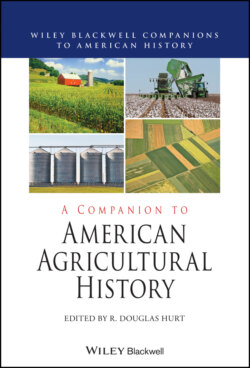Читать книгу A Companion to American Agricultural History - Группа авторов - Страница 34
Bibliographical Essay
ОглавлениеImmigration, especially in the North, contributed to dynamic rural societies. Scholars early on insisted on cultural differences and nationality determining crop choices and land use, among other considerations, but later access to land had most sway in immigrants’ decisions about where to locate; by and large they responded to the economic reality. For a discussion of the historiography of immigrants and agriculture see Brian Q. Cannon, “Immigrants in American Agriculture” (1991).
A spirit of reform and improvement took hold of many northern and southern agriculturalists alike. See William M. Mathew’s work on one of the more famous southern reformers, Edmund Ruffin and the Crisis of Slavery in the Old South (1988). Steven Stoll’s Larding the Lean Earth: Soil and Society in Nineteenth-Century America (2002) provides a more recent reassessment of northern and southern agricultural reformers, but also exhibits the growing use of environmental history in studies of agriculture.
Many additional worthy studies of antebellum rural life include Lee A. Craig, To Sow One Acre More: Childbearing and Farm Productivity in the Antebellum North (1993) and Conevery Bolton Valencius, The Health of the Country: How American Settlers Understood Themselves and Their Land (2002).
Whether they agree that a full transition to capitalism occurred or upon which types and classes of farmers embraced commercialism (and which rejected it), agricultural historians have been keenly interested in how this era changed society’s concept of farmers. Many historians and contemporaries would agree with Christopher Clark’s explanation that “Farmers and their households … were no longer the sole symbols of a republican social order” (1990 ). For the classic discussion of the “agrarian myth,” see Richard Hofstadter’s Age of Reform (1955).
In addition to Schermerhorn’s recent overview, there are several good general histories of American slavery, including David Brion Davis’s Inhuman Bondage (2006) and Ira Berlin’s volumes Many Thousands Gone (1998) and Generations of Captivity (2003). Fox-Genovese’s work is essential to the historiography of plantation households and inspired a number of investigations of planter women, but Thavolia Glymph’s Out of the House of Bondage (2008) is a good representation of the style of inquiry that has characterized the more recent scholarship.
While a complete bibliography of bottom-up studies of slavery is impossible to provide here, along with those cited in the chapter, the following works provide the student of American slavery with a sampling of how the literature has evolved: Kenneth Stampp, The Peculiar Institution (1956), Genovese, Roll, Jordan, Roll (1976), John Blassingame, The Slave Community (1979), Marie Schwartz, Born in Bondage (2000), Steven Deyle, Carry Me Back: The Domestic Slave Trade in American Life (2005), Jeff Forret, Slave Against Slave (2015).
U.B. Phillips’s American Negro Slavery (1918) is the most well-known example of early historians’ denial of the profitability of slavery. Phillips admitted that slavery tended to be capitalistic and concentrate wealth into the hands of the most enterprising, but contended that slavery did not profit slaveholders as much as free labor enriched modern industrial nations. Eugene Genovese argued that the system of plantation of slavery was “precapitalist,” representing a sort of feudal system that did not necessarily behave rationally or efficiently secure profit even as it produced a staple crop for a global market. Robert Fogel and Stanley Engerman painstakingly demonstrated the profitability and capitalism of slavery in Time on the Cross (1989). Soul by Soul: Life Inside the Antebellum Slave Market (1999), by Walter Johnson presented the slave trade as capitalist. Sven Beckert’s Cotton: A Global History (2015) argues that cotton is linked to the development of “war capitalism.”
Recent treatments of Americans’ conceptions between land, labor, and freedom include Mark Lause, Young America: Land, Labor, and the Republican Community (2005) and Max Grivno’s Gleanings of Freedom: Free and Slave Labor along the Mason-Dixon Line (2011). John Ashworth’s Slavery, Capitalism, and Politics in the Antebellum Republic (1995) provided a reassessment of the role of capitalism in sectionalism. For a few additional perspectives on the sectional crisis, see William J. Cooper, Jr.’s The South and the Politics of Slavery (1978), William Freehling, Prelude to Civil War (1994), and Edward L. Ayers, What Caused the Civil War? (2005).
